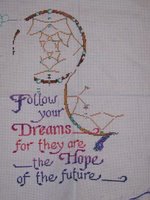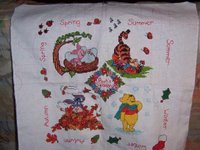I found this example essay on the net. It's pretty close to the bone. My stepsons were openly hostile about my very existence from before I met them. Not long after I met Paul, they tried to give him the ultimatum 'It's her or us!'. These days Michael, Luke and Nathan ignore my existence. They refuse to come to anything remotely resembling a 'family event' because I will be there. Paul goes to visit them but I wonder if the boys even realise that these visits are less and less because of the restrictions they put on him being able to tell them about his daily life with me. I wonder if they care ...
Wicked Stepmothers - Fact or Fiction?
Even as a small child most girls fantasize about the day they will become a beautiful bride. Yet for those that will not only get the husband of their dreams, but also a ready-made family, those fantasies may quickly fade into disillusionment. You never hear any little girl wish to be a stepmother when she grows up. However, experts say that by the year 2000 there will be more stepfamilies in America than intact biological families. Currently it is estimated that one out three Americans, an estimated 60 million adults and 20 million children, belong to a stepfamily (Misrach 89).
Sadly, the term stepmother is almost unheard of unless the word "wicked" is attached to the front of it. While mothers are thought to be loving and kind, what is it about stepmothers that gives them an immediate negative connotation? Are some women born with the word "wicked stepmother" stamped on their foreheads, as a form of predestination? Or does one become a "wicked stepmother" as a learned response that enables them to cope with a family situation? To become a stepmother one must first become a bride, and aren't brides, like mothers, usually associated with positive images? Yet, if upon becoming a bride that woman also becomes a stepmother, it's amazing how fast that image can be disposed of and replaced with the wicked stepmother syndrome.
Apparently this subject appealed to me because I, like many other women, became a bride and wicked stepmother in the same ceremony. In barely more time than it takes to wink an eye, one's life can be transformed from being a single person, to becoming a wife and stepmother. And while a wedding ceremony is rather abstract, meaning you feel no physical differences after it is performed except for a ring on your finger, the consequences and expectations of those two combined roles lend themselves to an interesting living situation. After 13 years of marriage and three stepchildren, I feel somewhat qualified to voice my opinion and theories on wicked stepmothers.
Not surprisingly, the stigma associated with stepmothers seems to be universally accepted. This can most likely be attributed to the origin of "wicked stepmothers" in folktales as far back as the 5th century (Watson 49). What is surprising is that the term is still very relevant today, and quite possibly for the same reasons that it came about many previous centuries ago. The word step comes from the Old English word steop. It is defined as "related by marriage rather than blood." Step is also associated with bereavement or loss, and in reference to stepmothers takes on several different meanings: such as one step removed, second best, or stepping into someone else's shoes (15). As a stepmother, all of these terms have felt familiar at one time or another throughout my family's relationship.
Seemingly, it appears that a positive relationship between a stepmother and her stepchildren was never expected. The ancient Greeks and Romans thought ill will from a stepmother to her stepchildren was a normal consequence of the relationship. They used several references to distinguish mother versus stepmother. If you were experiencing a lucky, or good day, it would be considered a "mother day." However if you were having a bad day, or unlucky day, it might be considered a "stepmother day." Men from the native country were from the "mother country," while immigrants were living in a "stepmother country" (3). As evident from these examples, stepmothers were certainly of less or no value, compared to a mother. In Greek mythology a dying wife made the following comment to her husband: "And do not remarry and impose on these children a stepmother, who, being a women more ill-intentioned than me through jealousy will lay hands on your children and mine. For a stepmother comes as an enemy to the children of a former union and is no more gentle than a viper" (7).
Although it comes as no surprise that stepfamilies present difficult situations, if you stop to think about it, why shouldn't they? They are somewhat like an arranged marriage. People that are barely more than acquaintances are expected to come together and live in the intimacy of one home (Brown 58). "One stepdaughter...likened the caution of a step relationship to an in-law one: You react spontaneously to a parent, and no matter how angry you become or how intemperate your speech, most of what is said in anger is forgotten. In dealing with a stepparent, you are conscious of your tone and your testimony...You're always aware of the relationship" (70).
Throughout the history of folklore stepmothers are portrayed as evil and self-centered. There seem to be three standard personality traits they possess: 1) sparked by jealousy they often mistreat or plot against their stepchildren. These schemes usually fail, and as a result the stepmother is punished or commits suicide by the time the story concludes (Watson 32). 2) Frequently the new stepmother and the stepchildren are relatively close in age. Therefore the stepmother, in several folktales, attempts to have an amorous relationship with her stepson. Of course for this to be a moral folktale the son must reject the stepmother's advances, thus creating a rage in her that ignites revenge. As a result, the stepmother often attempts to injure or kill her stepson (21). 3) The third most common plot in these stories is that the new stepmother is jealous that her husband's inheritance will be left to the son of another woman (26). Usually the tradition was to leave the inheritance to the oldest son. In all of these scenarios the stepmother is portrayed to be wicked, without morals, and greedy.
Interestingly, research completed in the late 1980s continues to depict stepmothers as the most negative members of a stepfamily. "Specifically, stepmothers were perceived as less affectionate, good, fair, kind, loving, happy, and likable, and more cruel, hateful, unfair, and unloving" (Dainton 94). Apparently, as in the distant past, there appear to be no gray areas when dealing with stepmothers. The stories all appear to be black and white, meaning the stepmother is always the villianess and the stepchildren are always innocent and pure. Regardless of the other characters involved in the story or family situation, the stepmother is always the one responsible for any displayed improper behavior. Occasionally in a folktale the character of the stepmother is symbolic of another character. For instance, in the story of Hansel and Gretel the witch and the stepmother actually portray the same personality traits and identity, therefore their characters could be interchangeable. And if you recall, at the end of the story the children successfully kill the witch and when they find their way back home, their stepmother has also died (Watson 43).
Throughout folktales good behavior of the stepmother is never an expected or important element of the story. If by chance the stepmother is kind it is very rare, and if she actually loves her stepchildren it is much rarer. However, if she does possess these characteristics it is because her stepchildren are careful to avoid any conflict with her. So in essence, it is not the personality or good behavior of the stepmother that causes her to be good and kind, but the personality and behavior of her stepchildren (9). In most folktales the stepchildren are always shown to be the victims, as the Greek and Roman writers tell the story from the perspective of the stepchildren (9).
Also, contrasts in personality and physical traits between the biological daughter and the stepsister(s) and stepmother often appear to be an element in many folktales, such as Cinderella, where Cinderella is beautiful and soft featured compared to the persnickety stepsisters and stepmother. The stepmother and stepsisters not only look mean, but they also have much sharper features and slightly contorted hairstyles. As in the story "Ashputtle" that we discussed in class, in regards to the stepsisters, "their faces were beautiful lily white, but their hearts were ugly and black" (Ashputtle 84). I also found two lesser known fairy tales that demonstrated similar traits, from a German folktale titled "Mother Holle," I took the following quote: "There was once a widow who had raised two girls, one her own daughter and the other her stepdaughter. She was devoted to her own child, even though the girl was selfish and lazy. The stepdaughter was hated by both mother and sister, even though she was generous and always willing to help. She was made to work from dawn to dark, and the silly girl never complained" (Evetts-Secker 22). The other example is from the Russian folktale, "Vasilisa the Beautiful." "The merchant soon chose another wife, a widow who had two daughters of her own. Vasilisa was hated by the stepmother and stepsisters because she was so lovely and kind. They were jealous of her right from the start. They treated her cruelly and gave her all the unpleasant work to do. And yet, no matter how abused and neglected she was, she still grew more and more beautiful, while the stepsisters sat around and got uglier by the day" (30-1).
Repeatedly, in folktales stepmothers are shown to be evil and self-centered, lacking self-control, exhibiting hostility, and acting on their sexual passions without regard to anyone else's concern. They are prone to jealousy motivated by beauty, as in Snow White, or because of monetary greed (Watson 26). Therefore, it is interesting that on the rare occasion that stepfathers are used in folktales they possess an opposite character persona, in contrast to the wicked stepmother. The kind stepfather gracefully accepts his stepchildren and treats them as his own. He mercifully takes in his new wife, often an unwed-mother and her illegitimate child, with loving arms. Stepfathers are never depicted as lusting after their stepdaughters (41-2). However, recent studies indicate that currently there is little difference in the perceptions of stepmothers and stepfathers in family situations (Dainton 94). Thus it appears that stepfathers may have taken a fall from their thrones in present times.
So why are stepmothers made to be the scapegoats, not only in fairy tales but in real life? Possibly in many instances it has to do with negative thoughts or images of the "real mother." However, since we all know that mothers contain only love and goodness, any negative feelings toward her are often displaced, redirected, or disguised in the form of a stepmother (Watson 47). During the time of Hansel and Gretel the peasant class in Europe was undergoing a great famine. Many families, unable to feed their children, attempted to dispose of them. Apparently, people found it much easier to accept that a stepmother would permit this, rather than blaming an actual mother (47). However, in the ancient past, as now, kids remain extremely loyal to their parents, "even if they abandoned them without a backward glance" (Misrach 90).
Unfortunately, stepfamilies are subjected to many conditions and situations that can easily create the potential for hate in the relationship. While it is somewhat unrealistic to expect a stepmother to experience the same love for her stepchildren as she does her own children, that does not mean that she hates her stepchildren (Watson 74). There are many factors that contribute to the emotional distress a stepfamily may experience. "Most children would resent their stepmother even if she were an angel sent straight from heaven. They are not in a position, often, to like anybody. Frequently they have been hurt and upset. They are obsessive about their father. They jealously guard the memory of their mother. They may feel insecure and unhappy about their future. A new stepmother is a threat in all kinds of ways" (79).
Furthermore, in some instances the stepmother, or new wife, may be jealous of the relationship her husband had with his former wife. This resentment may be transferred to the children, as they are visible and constant proof of that relationship. The stepmother may also resent having another woman's child living in her home. Sometimes the reason for this is not so much the maternity of the child, as the poor behavior of the child, and his/her unwillingness to conform to the household rules of the stepmother (74). Often children that have gone through divorce feel threatened and displaced. As a result they hesitate in accepting new authority figures and often act rude to the new parent (Millar 218). Seldom are new stepparents prepared to face the pain of being repeatedly rejected by their stepchildren. Some parents cope with this situation by trying even harder to be a good parent, while others deny their feelings until things eventually blow up and they have an argument with their equally angry stepchildren (Bloomfield 218). The stepmother may also be jealous of the time her husband spends with his children, as it distracts from the time they are allowed to spend together as a couple (Watson 74). Joan Giacomini, a university administrator and remarried parent in Seattle states that it is very difficult for stepmothers to realize they are not number one in their marriage to their new spouse. "There may be a handful of number ones, but you aren't the only number one." Being that the relationship between the parents and children predates the new marriage, that relationship if often given higher priority than the marriage. Love for a child is considered unconditional while love between a couple is not (Rutter 66).
In addition, the woman of the household, whether she be the mother or stepmother, is frequently responsible for the day to day care of running the house. Because women are raised to be nurturers it is very difficult for them to avoid family problems. According to Elizabeth Carter, co-author of The Invisible Web: Gender Patterns in Family Relationships, "When a stepmother sees the children as unhappy and the husband as ineffectual, she moves in to be helpful. This usually results in a lot of fighting between teen stepdaughters and step-mothers" (Misrach 66). Psychologists explain that all women, biological mothers, stepmothers, and even stepdaughters, are more likely to recognize and express distress whenever a problem occurs. However, in stepfamily situations women seem to be especially sensitive to interpersonal problems (66).
Apparently one of the main sources of conflict in a stepfamily is the role of disciplinarian. Authorities appear to be in disagreement over who should handle this responsibility in the family. Psychiatrist John Visher, M.D. and cofounder of the Stepfamily Association of America, is very adamant that only birth parents have the authority to discipline the children (Rutter 60). Dr. William Doherty, a family social scientist at the University of Minnesota agrees and feels it is important that stepparents avoid the temptation to interfere in the coparenting discipline process (64). However, Dr. Brown, a stepparent, disagrees with that philosophy. She thinks it's important that the stepmother plays a role in the discipline process in her home or she will be considered an intruder, although the stepmother should not be the primary disciplinarian (Brown 117).
For this reason, the majority of the disciplinary problems in a stepfamilly, causing the stepmother to be set up as the evil stepmother, occur when the biological father fails to take a clear responsibility in the disciplinary procedures regarding his children (Rutter 32).
Unfortunately many divorced parents feel guilty and choose to compensate their children by becoming good-time moms and dads who refuse to set limits for their children. They justify this by thinking that their children are already upset and they don't wish to upset them any further. However, this usually results in the stepparent being forced into the primary disciplinarian role and they become the bad guy to their stepchildren (Millar 218). And Pearl Ketover Prilik, author of Stepmothering Another Kind of Love has this to say: "The reality is that these marriages break up because the husband and wife can't - or won't - work through problems dealing with the children. Often the overindulgent father, guilty about the divorce, can't or won't set limits, and the new marriage takes a beating. The father wants to be the kids' best friend and so the stepmother ends up being the disciplinarian" (Misrach 90).
As a result, the stepmother is left to disciplining and assigning household chores to her stepchildren. To an outsider this often appears as cruelty. However if those were her biological children, those same outsiders would be praising the mother for instilling responsibility and manners in her children. Since they are stepchildren, many outsiders have sympathy for these innocent children, deprived of a mother, and they expect hostile behavior from a stepmother (Watson 80).
Further research shows that women take their stepfamilies very seriously and personally, linking their parental and family role with their self-value. A large part of a woman's self-esteem depends on her stepfamily relationship going smoothly. Therefore when family situations are negative a stepmother suffers from low self-esteem and feelings of insecurity and guilt. Unfortunately this creates a vicious cycle, as the worse the mother feels about her family role, usually the more "stepmothery" behavior she displays (81). Ultimately, women must learn to be more tolerant of their own human failings and realize that all parents make mistakes and experience challenges, not just stepmothers (Brown 70).
While society recognizes that a stepfamily is born of loss, through divorce or death, it often fails to recognize that a stepmother has also suffered a loss. This is especially evident if the stepmother is in her first marriage and has no children of her own. This woman has traded her romantic visions of marriage and privacy for a man that both she and her stepchildren love (67).
Meanwhile, somewhere in the transition from the biological mother to the stepmother, society has reduced the privileges supporting marriage for wife number 2. Is it fair for the rules to change here? Shouldn't spouses be first to one another, and the children, regardless of whose they are, come after that relationship? If a partner is unable to commit this much to his/her new spouse, possibly that person should refrain from getting remarried. Also, stepchildren should be taught by their biological parent to respect their new stepparent. You cannot force a person to like or love another person but you can demand respect. Many biological parents seem to accept the rude attitude and actions of their children toward their new spouse without question.
Not surprisingly, stepmothers appear to take the brunt of blame for turmoil in a stepfamily living arrangement. However, if stepmothers are so evil, how is it that 80% of the children placed under these women develop into fine adults without behavior problems (Rutter 33)? Much of the available research on this topic seems to indicate that stepmothers should supply all the needs of the children and home, yet have no voice in the discipline of the involved children. Isn't this an insult to women? As an adult partner in a marital relationship, shouldn't women be allowed a decision in how behavior will be judged or rewarded in their home? And while it is probably a good idea for the biological parent to assume the major role in discipline, what if that parent chooses to disregard or ignore the inappropriate behavior of his children? Is it reasonable to expect the stepparent to avoid discipline measures also? Under this situation who is in control of the household? Definitely not the parents. "Conflicts are inevitable and should be expected. But biological parents risk turning their new spouses into the stereotypical evil stepparents when they don't support their spouse's rules and decisions. Without that support, experts say, stepparents have little, if any, influence over their stepchildren" (Whetstone 106).
Furthermore, like many things in life, only the ones that have had the actual experience are truly qualified to define it. Often stepfamilies seem to be being judged by others as to how they relate to each other. In reality, stepfamilies probably have many conflicts similar to an intact or "normal" family. However, intact family disputes are not openly aired and discussed, in comparison to stepfamilies. As Fern Kupfer stated in Parents Magazine: "Being a stepmother is, simply, one of the most difficult things I've ever done. I imagine saying that to my stepdaughters. How would they respond? 'The most difficult thing you've ever done! Were we so terrible?' 'No.' I'd say, 'but you'll understand if you become a stepmother" (Kupfer 162).
In conclusion, there certainly is some truth to the negative role of the stepmother in society. However, it was probably a learned defense mechanism. As a survival technique stepparents that wish to remain married to an ineffective disciplinarian must learn to create some form of order in the household. Unfortunately this is often interpreted as interference by the stepchildren and frequently meets with criticism from the spouse. However, if the spouse, the biological father, were more willing to take control of the discipline and set some rigid standards for his children in the household, it wouldn't be necessary for the stepmother to do these things. Chances are, under that management, the stepparent would be thought of more graciously by her family.
Unfortunately, myths making stepmothers the universal scapegoat for conflict in stepfamilies display prejudice and exaggerations which appear to be unfounded (Watson 71). Likewise, many of the stereotypical associations that originally created the wicked stepmother phenomena, centuries ago, continue to be fueled today with similar underlying currents. "The point is frequently made by contemporary sociologists that the negative perception of the stepmother as invariably wicked, while obviously a gross exaggeration, has a factual basis to the extent that there are elements inherent in the stepfamily situation which may help to reinforce this concept. These involve personal conflicts which have nothing to do with inheritance disputes, but are generated by the pressures of day to day living" (73).
Finally, some researchers feel the only way to change this connotation plaguing stepmothers is to change the image associated with stepmothers. Therefore, the first step would be to replace the old fairy tales, involving evil stepmothers, with new stories expressing a more positive message. However, since there are at least 345 versions of just Cinderella, this would be a nearly impossible task. They also suggest redefining the boundaries of the accepted form of motherhood, thus allowing the outcasted stepmother to become a normal and understood image of a mother. Their last thought is to prove the stigma of the wicked stepmother to be false. However this would involve a "global public relations campaign for stepmothers" (97). While all these ideas look good on paper, in reality they all present an unrealistic approach in detouring the vast, world-wide concept of the "wicked stepmother."
All in all, the fact that stepmothers are chosen to play such a negative role says something about our world's society. "Hansel and Gretel, Cinderella, and Snow White revolve around the actions of an evil stepmother. These stories may appear innocuous enough, unless of course you happen to be a stepmother or a stepchild. Fairies do not exist, and witches do no exist, but stepmothers do exist, and therefore certain fairy tales are harmful rather than helpful to large segments of the population" (93).
Works Cited
"Ashputtle." Grimms' Tales For Young and Old. (class handout).
Bloomfield, Harold H. M.D. "Stepparenting: Getting to the Heart of Problems."
Parenting. April 1993.
Brown, Dr. Beth. When You're Mom No. 2. Ann Harbor, Michigan: Servant
Publications. 1991.
Dainton, Marianne. "The Myths and Misconceptions of the Stepmother Identity." Family Relations. January 1993.
Evetts-Secker, Josephine. Mother and Daughter Tales. New York: Abbeville Press. 1996.
Kupfer, Fern. "The Cinderella Syndrome." Parents Magazine. August 1996.
Millar, Heather. "Stepparents: Enforcing the Rules With Kids." Parenting. November 1994.
Misrach, Myriam Weisang. "The Wicked Stepmother & Other Nasty Myths." Redbook. July 1993.
Rutter, Virginia. "Lessons From Stepfamilies." Psychology Today. May/June 1994.
Watson, Patricia A. Ancient Stepmothers Myth, Misogyny, and Reality. New York: E.J. Brill. 1995.
Whetstone, Muriel L. "The Myths and Realities of Stepfamilies." Ebony. September
1996.
http://www.siskiyous.edu/class/engl12/stepmom.htm


















